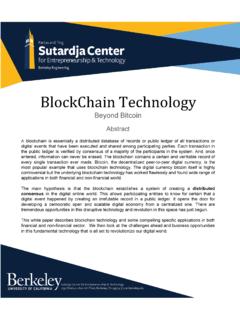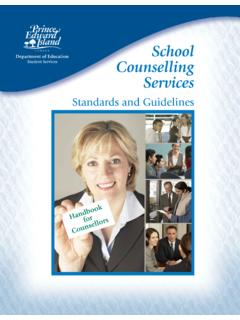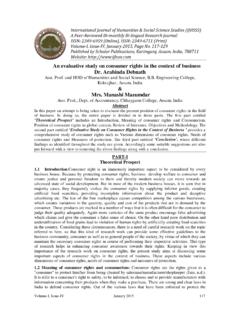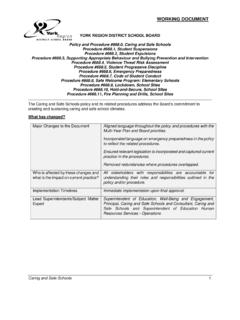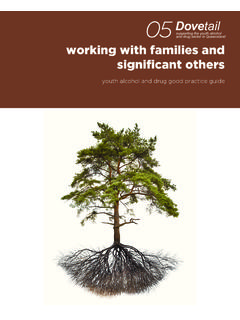Transcription of Conflict Resolution in Schools - VADR
1 VADR Conflict Resolution in Schools n any school community there is the potential for Conflict . Students may misunderstand each other. Teachers may disagree on resource allocation. Parents may diverge on how the school should be. Emotions can run high on a variety of issues. The potential for Conflict exists because people have different needs, views and values. The challenge for Schools , as for the wider community, is to find ways of managing Conflict constructively so that those involved can learn and grow from the experience. The purpose of this guide is to encourage and help Schools to achieve co-operative and supportive working relationships between staff, students and parents. It describes a positive problem-solving process, mediation , which, when utilised by Schools , leads to less Conflict and better outcomes for all involved.
2 The guide should be a useful resource for staff, students and parents. Each school may develop a range of strategies for the effective prevention and management of Conflict . These strategies could include training in Conflict Resolution skills and co-operative classroom processes and procedures for resolving grievances. mediation is one effective and empowering strategy for successful Resolution of Conflict . mediation is a positive problem-solving process that can prevent conflicts and misunderstandings from becoming protracted and destructive disputes. It aims to help people resolve their differences. It helps disputing parties to assess their options realistically and reach mutually acceptable solutions. The mediation process encourages future co-operation. It is a structured, goal-directed process that follows clear steps, and resolves disputes confidentially.
3 An independent third party, the mediator, helps the parties to talk with one another, and to listen to one another s grievances. Through this exchange of information parties gain insight into how the other is feeling about the situation, and they achieve understanding and respect. The mediator focuses discussion between the parties on problem-solving rather than blame and punishment. While other methods of Conflict Resolution in Schools may involve a solution or decision being imposed upon the parties by someone in authority, mediation invites parties to formulate their own solutions, and to take responsibility for their actions. mediation is a Conflict Resolution process that can be applied across the school community. As such, it is an ideal process to integrate into whole school community policies and procedures.
4 2 Why does mediation work? For people to be satisfied with the way a dispute or problem has been resolved, they need to feel that: The process was fair, ie their issues were heard and understood The agreement or decision reached was reasonable and fair The relationship between parties has been helped by the process They can manage their relationship in the future mediation can achieve these results. What can be mediated? Many common conflicts in Schools can be mediated. Some examples of student/student, parent/parent, teacher/teacher, parent/ school , teacher/student and teacher/administration disputes are listed below. Student/Student Name calling Teasing Exclusion Friendship problems Rumours Property issues Fighting Parent/Parent Supervision Discipline Bullying Teacher/Teacher Curriculum Resources Teaching strategies Personal style Parent/ school Student management Class or form group allocation Catering for individual learning needs Personality clashes Uniform Co-curricular demands Homework demands Teacher/Student Work loads Homework Punctuality school responsibilities Behaviour Teacher/Administration Working conditions Duties allocation Peer mediation As part of a whole school approach to student welfare, Schools may consider introducing peer mediation .
5 Often student/student disputes can be resolved best by student mediators. Students can be trained in the skills of mediation so that they can act as mediators for their peers. Not all conflicts may be suitable for peer mediation . Other processes may be more appropriate in situations involving assault, theft, alcohol or drug use. Peer mediation programs must be co-ordinated by staff trained in mediation who provide ongoing support to student mediators. Well developed whole school Conflict management and curriculum plans will often include peer mediation as one program valuable for the school to implement as part of the big picture of school based dispute Resolution . McMahon, C. (1998). The national and international perspective on peer mediation : A need for a whole school approach for meaningful change.
6 Paper presented at the 4th National mediation Conference. Teaching every student how to negotiate and mediate will ensure that future generations are prepared to mange conflicts constructively in career, family, community, national and international settings. Johnson, & Johnson, (1995). Teaching students to be peacemakers: The results of five years of research. Peace and Conflict : Journal of Peace Psychology, 1, 417-438. Basic Steps in mediation 1. Creating the context a comfortable and private space and sufficient uninterrupted time are provided 2. Explaining the process the purpose and ground rules of mediation are discussed 3. Listening to what happened both sides are enabled to tell their story in turn and without interruption 4. Defining problems and concerns concerns are clarified and an agenda is set by the mediator with participants 5.
7 Focusing on the future and finding solutions solutions that suit both parties are sought from the parties themselves 6. Concluding a shared agreement is confirmed and sometimes written down. A mediator uses the following skills: A non-judgemental tone of voice and impartial body language Questions that will lead the discussion forward Active listening Acknowledgement of feelings Positive reframing of information Training People interested in becoming mediators will need training to develop and refine their skills of mediation . Training provides the opportunity to learn the steps of mediation , practice the skills required in the process and discuss potential difficulties or ethical issues that might arise during the mediation session. mediation training also has the added benefit of allowing people to develop or enhance life and communication skills that are relevant to all relationships.
8 Undergoing a training course in mediation is essential for key personnel in a school whose roles involve management of students and staff and who liaise with parents when problems arise. Having a group of trained mediators from the staff, parent and student bodies would be valuable for cross-group conflicts where mediators would work together modelling co-operation. At times it may be more appropriate to call in an independent mediator from outside the school . Schools implementing peer mediation should develop links with professional mediators who can provide ongoing consultation and support. The Ideal System of Conflict Resolution Adapted from Cohen, R. (1995) . Students resolving Conflict : Peer mediation in Schools .
9 Glenview, Illinois: Goodyear Books Arbitrated conflicts conflicts that are mediated conflicts that people will resolve by negotiating with each other conflicts that never occur because of a supportive school environment 4 Whole school approach* mediation should be part of a whole school approach to the management of Conflict . When energies are not wasted in unproductive Conflict , better teaching and learning can take place. The aim would be to create a whole school community that manages the conflicts with skill and insight, constructively rather than destructively. In such a school Conflict would be approached as an opportunity for learning and growth. What would a whole school approach to Conflict look like? 1. The whole school approach would have clear Conflict management polices and procedures. These would be integrated with school policy areas such as equal opportunity, anti-harassment/bullying, and welfare and discipline and occupational health and safety policies.
10 2. The school administration would model effective management of Conflict 3. Staff would model positive, co-operative and collaborative relationships 4. Staff would use co-operative processes in the classroom 5. Training in Conflict management skills would be included in the curriculum 6. All staff would receive professional development in Conflict management 7. The school would engage in partnership with local community organizations and groups to develop approaches to the prevention of Conflict .# NB. The whole school model links to the Department of Education, Employment and Training (DEET) (1999), Framework for student support services in Victorian government Schools . * Adapted from the work of David and Roger Johnson, University of Minnetsota #Coleman, P. & Deutsch, M. (2001). Introducing co-operation and Conflict Resolution in Schools : A systems approach.
